A Twitter acquaintance recently posted a link to a Cessna 172N Skyhawk that was for sale. His comment had to with the Apollo 618 Loran C navigator and ADF receiver the airplane still had in it: “Why would you choose to list a Loran and an ADF in your aircraft sale description?“ It’s a good question, and Exhibit A that the airplane hadn’t spent much time in an avionics shop over the last few years. (The U.S. Coast Guard shut down its Loran C transmitters in 2010.) The Skyhawk did have an ADS-B Out installation, however, so its owner did know newer technologies exist. Why didn’t the owner have the Loran and/or ADF removed when ADS-B was installed?
It’s a good question. Many pilots today haven’t flown with an ADF, which started going out of style in the 1990s when the FAA decreed GPS was a legal substitute for NDBs under certain conditions. For both Loran and ADF receivers/NDB transmitters, the end came with neither a bang nor a whimper. One day the industry woke up and decided we didn’t need them any more, something certainly true for Loran. (That said, newer Loran technologies might be a good backup to GPS if they were implemented.) Since then, GPS has been the go-to navigation system, and the FAA is well on its way to implementing its minimum operational network of VORs throughout the U.S.
The real-life answer to why the two door stops were still in the Skyhawk’s panel probably had to do with the owner’s finances, the airplane’s mission and, maybe, nostalgia. The thing is, I get the nostalgia part, and kind of miss having a decent ADF in the panel. One with good reception and audio could pick up clear-channel AM stations hundreds of miles away and, while the programming might not be the most creative, baseball games were a staple. And although I didn’t think so at the time I was learning it, using an ADF and shooting an NDB approach was actually kind of fun.
For one thing, it was very analog, since with most combinations of instrumentation, there was some mental math required to establish the correct course to or from the station. When nearing the station, you knew if the course was correct by whether the ADF needle moved.
When it comes to airmanship, nailing an inbound NDB course was definitely a cool skill to have. Flying away from the station was much less accurate, although it helped if you had been inbound, crossed it and were maintaining the same course outbound. They also were handy when not in use for navigation: Their frequency dial and rotatable compass rose could be used to quickly “jot” down certain numbers—like decision height or missed-approach heading—by dialing them in.
The other cool thing about the ADF is you could use a nearby AM broadcasting station as a faux NDB, and cobble together a training-only approach procedure that kept you away from the real ones, which typically were co-located with an ILS approach’s outer marker, resulting in a locator outer marker, or LOM. I spent a lot of time sweating out such a procedure back in the day.
Around the same time, I had professional relationships with a number of pilots in long and productive careers working with the FAA, not as employees but as consultants and, sometimes, adversaries. One day, the discussion rolled around to whether one thing or another the FAA allowed was “safe.” Being younger and much less experienced than these old pelicans, I made some statement to the effect an NDB approach wasn’t safe. That’s when I was introduced to risk management in the real world.
![]()
The experienced response went something like, “If the FAA allows it, it’s safe. It might be more prone to error than another option, and perhaps riskier as a result, but it’s safe if flown correctly.” I realized there was a large kernel of truth in that statement. And an NDB approach is a great example.
Thanks to its relative inaccuracy when compared to, say, an ILS or even a VOR, an NDB procedure’s minimum altitude generally was higher than either of the other two. This accounted for the greater likelihood that even a well-flown NDB approach could place the aircraft outside the areas protected for an ILS or VOR procedure, by requiring higher minimums. It probably also considered that even a sloppily flown VOR or ILS procedure offered greater accuracy and likelihood of success than the NDB.
The point is that an NDB procedure was “safe” when flown correctly. But the NDB was less accurate and more difficult to fly precisely. Therefore, it was riskier, mainly because it was easier to make a mistake.
It’s easy to point to such a distinction and extrapolate to other operations and rules, and their relative risk. It’s also easy to point to existing rules, procedures and guidance that leave open to interpretation whether a pilot should fly a certain flight. For example, it might be legal—and therefore “safe”—for a Part 91 pilot to fly 10 or 12 hours out of a workday, but it can be risky, especially during the 11th hour. Extrapolate it far enough, and we’d never leave the house, much less fly personal airplanes.
— Jeb Burnside




